Key Points:
- Shingleback lizards are unusual Australian animals that mate for life and have live births of their young. Male and female pairs share parenting duties and sometimes walk side-by-side while nuzzling.
- Mute swans are the famously monogamous waterfowl that couple up for good around the age of three.
- The faithful marmoset monkeys live with their mates for most of their 12 to 16-year life span. The pairs groom each other and share food, while the males care for the babies.
What animals mate for life? There are many creatures in the animal kingdom that have different mating partners throughout their lives. There are also monogamous animals. These mating pairs stay together throughout their lives.
This list of animals that mate for life contains birds, mammals, and reptiles.
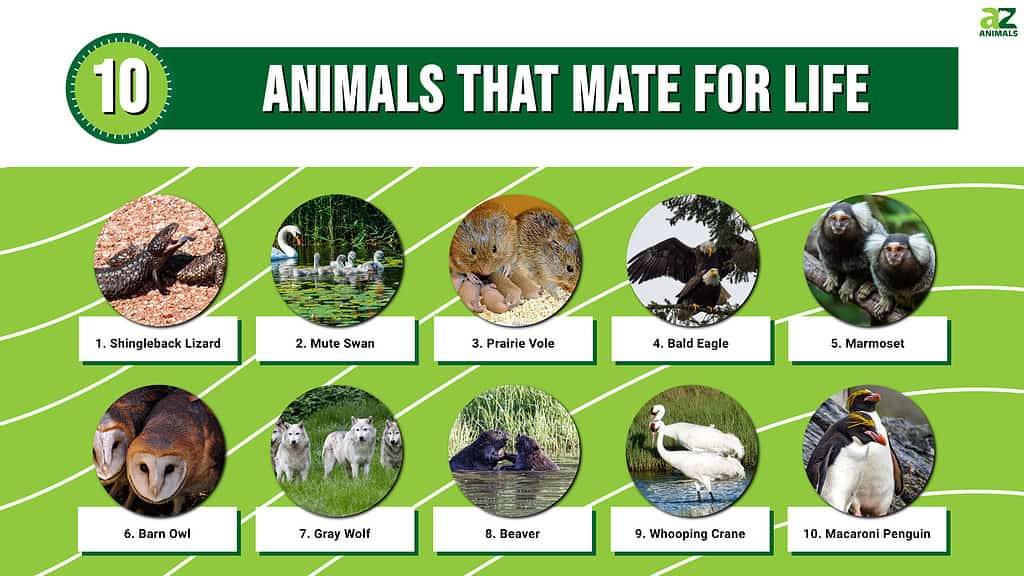
#10 Macaroni Penguin
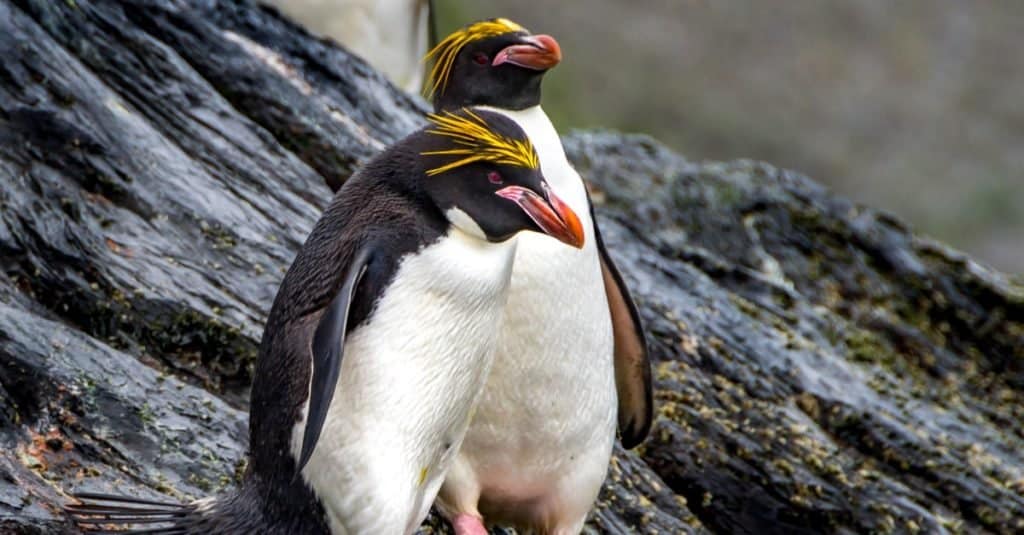
Both male and female macaroni penguins play important nurturing roles in raising a chick.
©Tetyana Dotsenko/Shutterstock.com
These penguins reach sexual maturity at about five years old. A male macaroni penguin attracts a female by bowing and bobbing its head. Once they pair up, they’re lifelong mates. Some of these penguins live as long as 15 years. After the female lays the eggs, the mother and father take turns sitting on them and hunting for food. Once the egg hatches, the male cares for the hatchling the first month while the female takes on foraging duties.
Macaroni penguins are very social birds and dwell in colonies that can number up to 2.5 million individuals. They are active day and night, spending day hours foraging in the water at depths of 65-262 feet (20-80 meters). At night, they only dive up to 65 feet (20 meters). They feed on krill, but overfishing has threatened the numbers of krill, which in turn has had a negative effect on these birds.
The conservation status of the macaroni penguin is Vulnerable with a decreasing population.
Learn more about the lifelong devotion of the macaroni penguin here.
#9 Whooping Crane

Whooping cranes choose a lifelong mate at three years old.
©William Cushman/Shutterstock.com
At three years old, a whooping crane chooses a lifelong mate. These birds hop, dance, and flap their wings as part of the mating ritual.
The male and female whooping crane work together to build a nest in the mud using bulrushes. Normally, the female lays just one egg and the pair shares the duty of keeping it warm. After the egg hatches, the parents continue to care for the chick for nine months. These birds can live as long as 30 years! However, if one in a couple dies, the survivor is known to go in search of a new mate.
The conservation status of this bird is Endangered with a decreasing population.
Discover more facts on the whooping crane aka the tallest bird in North America.
#8 Beaver

The female beaver cares for the kits while the male finds food and defends the nest.
©Telly/Shutterstock.com
Beavers reach sexual maturity at about two years old. A female releases a scent to let the male beavers around her know she’s ready to mate. After pairing up, beavers stay together for life.
After the beaver kits are born, the female cares for them while the male finds food and defends the nest. The mother and father continue to care for the kits until they reach two years old. Beavers can live up to 10 years in the wild.
The conservation status of the beaver is Least Concern with a stable population.
Discover more on beavers here including how they make their dams.
#7 Gray Wolf
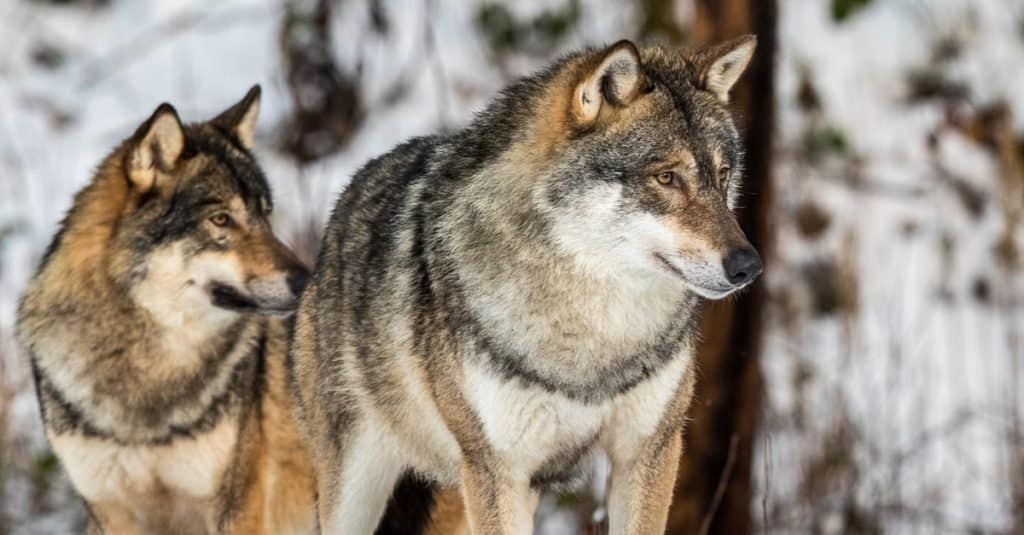
The female gray wolf has a litter of up to nine cubs once per year.
©Lillian Tveit/Shutterstock.com
Gray wolves are animals that mate for life and live in Alaska as well as Wisconsin, Michigan, and Idaho. These monogamous canines reach sexual maturity at about three years old. A female gives off a scent when ready to mate.
The female gray wolf has a litter of five to nine cubs just once per year. She takes care of the cubs in the den while the male goes out to hunt for prey to feed his family. The male stands guard over his young to protect them. Gray wolves on average live for six to eight years in the wild, although they can live for up to 13 years.
The conservation status of the gray wolf is Least Concern with a stable population.
Learn more about wolves and their pack activities here!
#6 Barn Owl

The barn owl, which mates for life, is a cavity nester, readily using human-made structures to nest.
©Joanne Harris and Daniel Bubnich/Shutterstock.com
This monogamous bird is best known for its heart-shaped face. These owls reach sexual maturity aged one.
A male barn owl has a special call when searching for a mate. Once a female is interested, the male tries to feed her. If she accepts food, they become a pair! A barn owl pair preen one another sitting side by side.
The female creates a nest in a tree for her eggs. Once her eggs hatch, she stays in the nest to care for them. Meanwhile, the male hunts for prey to bring back to the nest. After the babies, or owlets, are three weeks old they can be left alone allowing the pair to hunt for food. They care for the owlets until they’re 13 weeks old.
Their conservation status of the barn owl is Least Concern with a stable population.
Look at some other facts about the barn owl right here.
#5 Marmoset
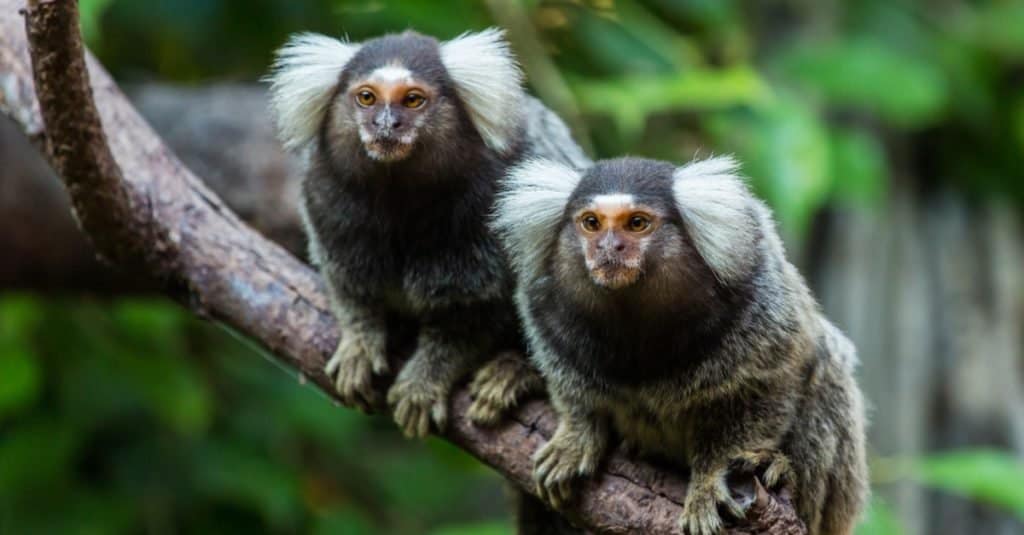
Female marmosets give birth to twins twice per year, and the male marmoset is the main caregiver.
©konmesa/Shutterstock.com
These tree-dwelling monkeys live in the rainforests of South America. They reach sexual maturity at 18 months old and live for around 12-16 years.
Once they compete for their mates, marmosets hang onto just that one lifelong mate. Female marmosets give birth to twins twice per year. The male marmoset is the main caregiver in the family. Marmoset pairs routinely share food and groom each other’s hair.
The pairs live within larger family groups called troops, containing about 15 monkeys. Only the “top” male and female pair end up having babies.
The marmoset’s conservation status is Least Concern with a decreasing population.
Discover more about the marmoset including how these monkeys communicate.
#4 Bald Eagle
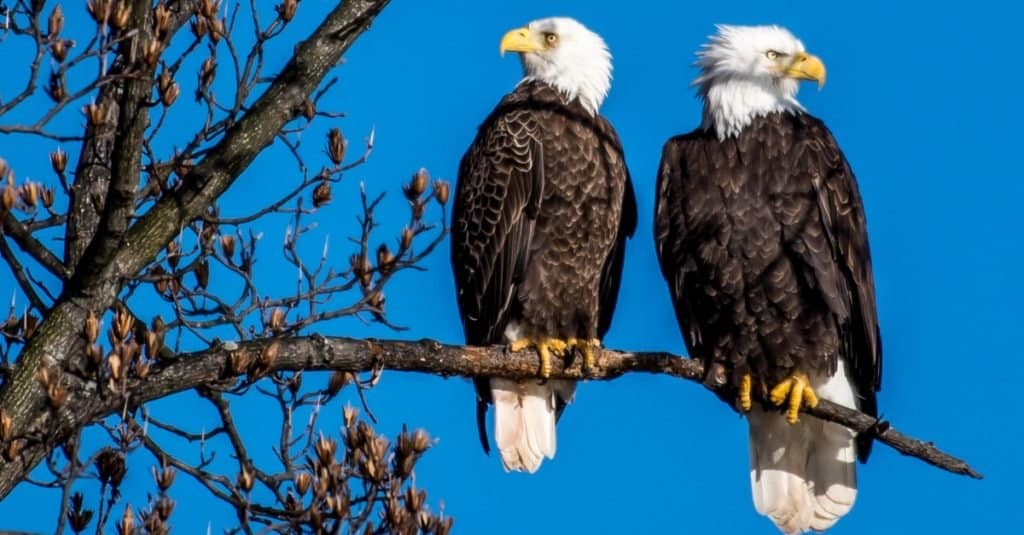
The bald eagle has been the national emblem of the U.S. since 1782, and is another animal that mates for life.
©Krumpelman Photography/Shutterstock.com
Bald eagles live in the United States and Canada. These birds are sexually mature at five years old. As a courtship ritual, for these animals that mate for life a male and female grasp talons and spin together in the air.
Generally, a female lays two eggs in a clutch. Both the female and male take turns sitting on the eggs. The male goes out to hunt for food for the female and the chicks. The chicks fledge at around 11 weeks old and will soon be independent. Eagles can live from 20 to 30 years in the wild.
The eagle’s conservation status is Least Concern with an increasing population.
Check out more interesting facts about the bald eagle here.
#3 Prairie Vole
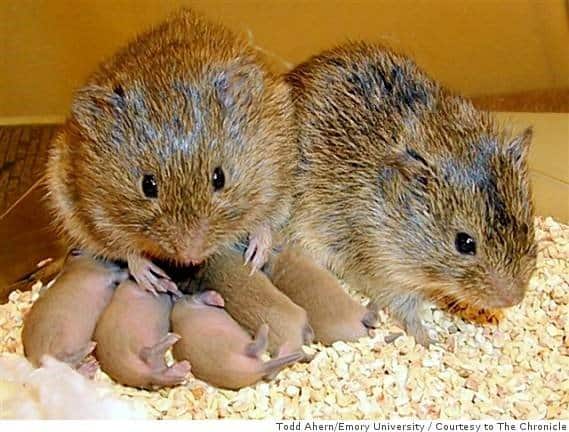
Prairie voles love to touch, as it allows communication between mates.
©theNerdPatrol / flickr – License
These monogamous rodents live in grassy fields in the central part of the United States as well as in southern Canada. The prairie vole reaches sexual maturity at about 40 days old. Male prairie voles aggressively compete with other males for the attention of a female.
A female prairie vole has two to four litters per year. Each litter can contain up to seven pups. The male and female share the responsibility of building a nest as well as feeding for their pups. The pups are able to live independently at just two weeks old. These rodent pairs groom one another and huddle together in their burrow.
The conservation status of the prairie vole is Least Concern with a stable population.
Learn more about the busy lives of voles right here.
#2 Mute Swan

Mute Swans, mating for life, are the elegant birds of Russian ballets and European fairy tales.
©Sergei25/Shutterstock.com
When considering what animals mate for life, mute swans immediately come to mind. They are found in the Great Lakes as well as ponds and lakes in the Pacific Northwest. These birds can live up to 10 years.
Male and female mute swans pair up at around three years old. Males and females work together to build a nest of grass and cattails. They take turns sitting on their eggs and feeding the chicks aka cygnets.
The conservation status of swans is Least Concern with an increasing population.
Learn more about the mute swan including why these birds mate for life.
#1 Shingleback Lizard

Shingleback lizards mate for life, which is very unusual among lizards.
©Ken Griffiths/Shutterstock.com
These lizards live in Australia. Males compete for females by fighting other males and establishing dominance. Once a female and male pair up, they stay together.
Shingleback lizards give live birth to their young and share the feeding duties. The young are able to live independently just days after birth. Scientists have observed these monogamous reptiles walking side by side and rubbing their heads together.
The conservation status of the shingleback lizard is Least Concern with a stable population.
Learn more about the unique characteristics of reptiles like the shingleback lizard right here.
Summary of World’s Top 10 Animals That Mate for Life
Here’s a recap of the 10 animals that mate for life which we took a look at:
| Rank | Animal |
|---|---|
| 1 | Shingleback Lizard |
| 2 | Mute Swan |
| 3 | Prairie Vole |
| 4 | Bald Eagle |
| 5 | Marmoset |
| 6 | Barn Owl |
| 7 | Grey Wolf |
| 8 | Beaver |
| 9 | Whooping Crane |
| 10 | Macaroni Penguin |
The photo featured at the top of this post is © Dark_Side/Shutterstock.com
Thank you for reading! Have some feedback for us? Contact the AZ Animals editorial team.






